Satas D., Tracton A.A. (ed.). Coatings Technology Handbook
Подождите немного. Документ загружается.

This Page Intentionally Left Blank
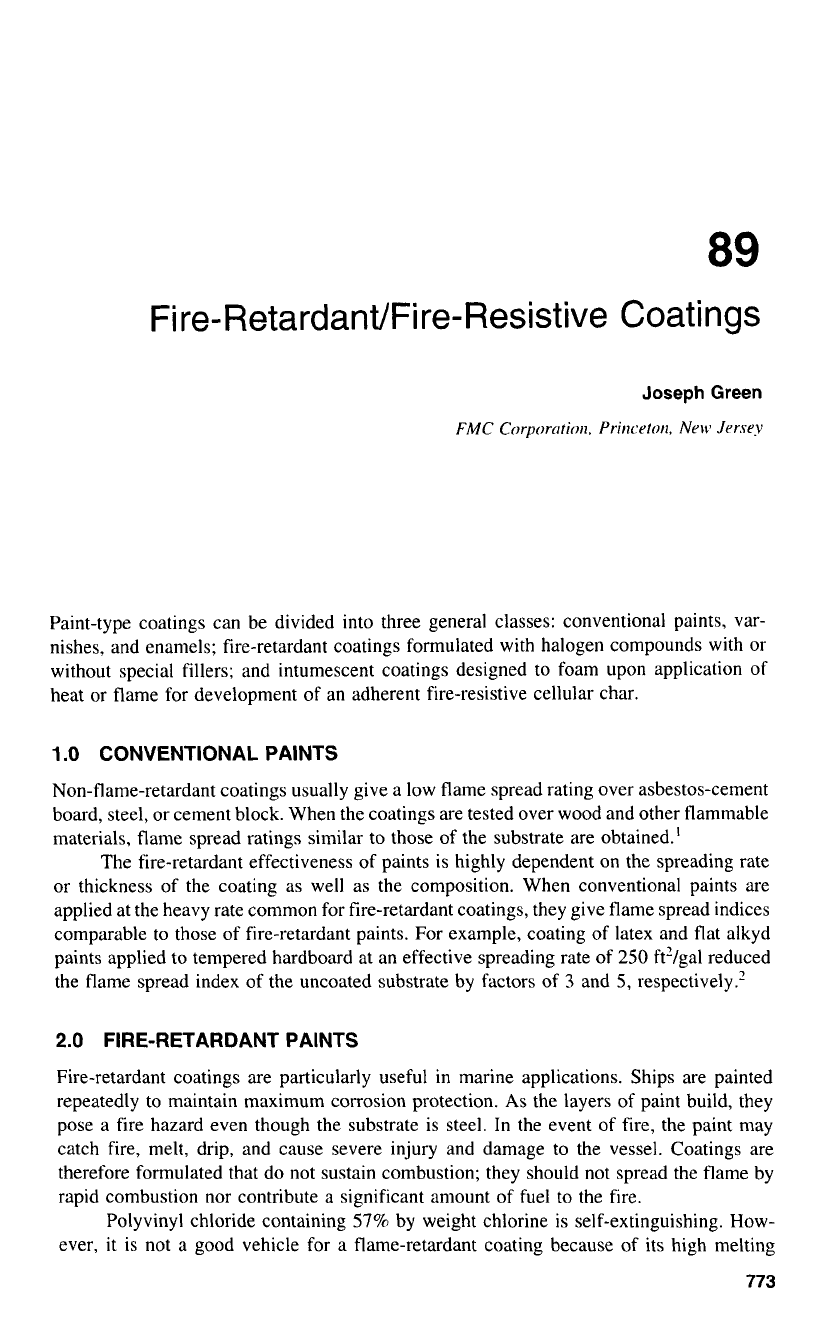
Fire-RetardanVFire-Resistive
Coatings
Paint-type coatings can be divided into three general classes: conventional paints, var-
nishes, and enamels; fire-retardant coatings formulated with halogen compounds with or
without special fillers; and intumescent coatings designed to foam upon application of
heat
or
flame for development of an adherent fire-resistive cellular char.
1
.O
CONVENTIONAL PAINTS
Non-flame-retardant coatings usually give a low flame spread rating over asbestos-cement
board, steel, or cement block. When the coatings are tested over wood and other flammable
materials, flame spread ratings similar to those of the substrate are obtained.’
The fire-retardant effectiveness
of
paints is highly dependent on the spreading rate
or thickness of the coating as well as the composition. When conventional paints are
applied at the heavy rate common for fire-retardant coatings, they give flame spread indices
comparable to those of fire-retardant paints. For example, coating
of
latex and flat alkyd
paints applied
to
tempered hardboard at an effective spreading rate
of
250
ft’/gal reduced
the flame spread index of the uncoated substrate by factors of
3
and
5,
respectively.’
2.0
FIRE-RETARDANT PAINTS
Fire-retardant coatings are particularly useful in marine applications. Ships are painted
repeatedly to maintain maximum corrosion protection.
As
the layers
of
paint build, they
pose a fire hazard even though the substrate is steel. In the event of fire, the paint may
catch fire, melt, drip, and cause severe injury and damage to the vessel. Coatings are
therefore formulated that do not sustain combustion; they should not spread the flame by
rapid combustion nor contribute a significant amount of fuel to the fire.
Polyvinyl chloride containing
57%
by weight chlorine is self-extinguishing. How-
ever, it is not a good vehicle for a flame-retardant coating because
of
its high melting
773
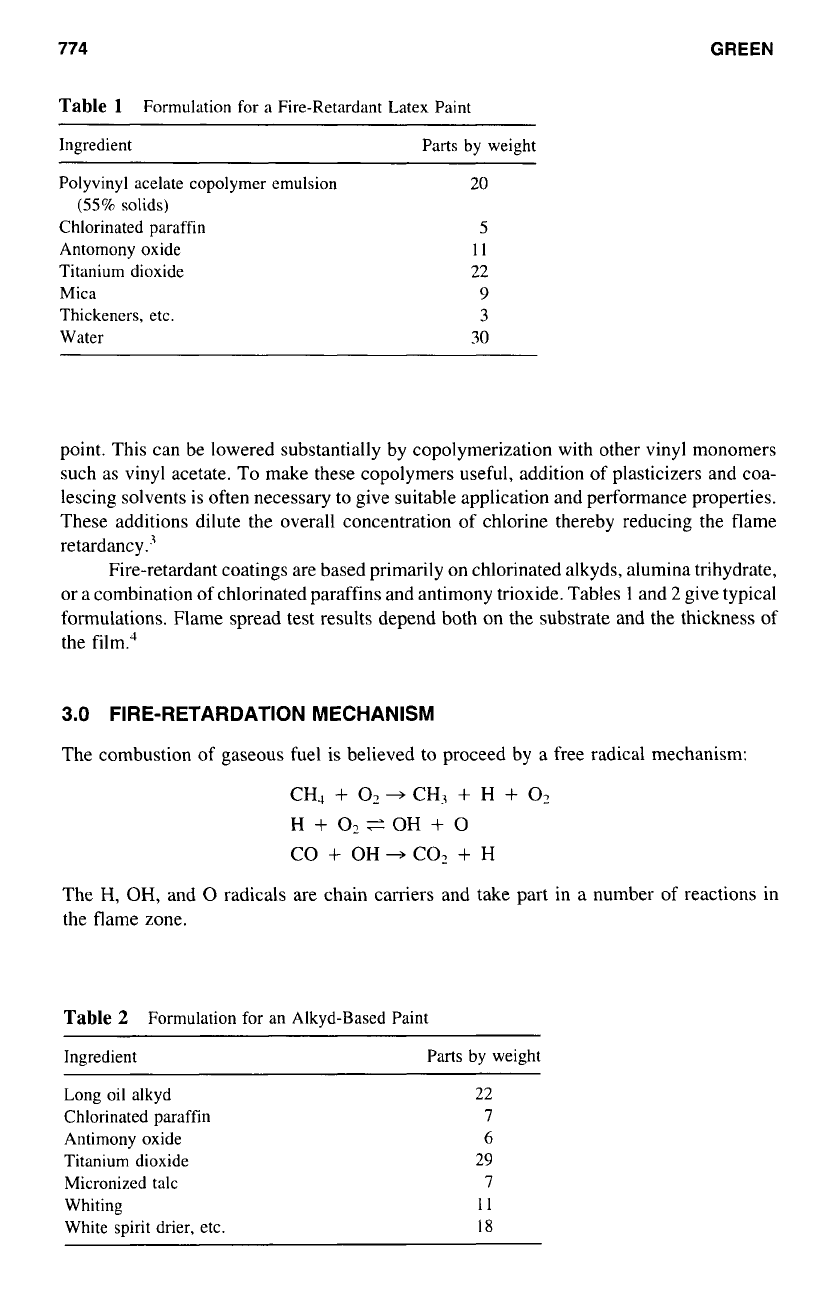
774
GREEN
Table
1
Formulation
for
a Fire-Retardant Latex Paint
Ingredient Parts by weight
Polyvinyl acelate copolymer emulsion
(55%
solids)
Chlorinated paraffin
Antomony oxide
Titanium dioxide
Mica
Thickeners, etc.
Water
20
5
II
22
9
3
30
point. This can be lowered substantially by copolymerization with other vinyl monomers
such as vinyl acetate.
To
make these copolymers useful, addition
of
plasticizers and coa-
lescing solvents is often necessary
to
give suitable application and performance properties.
These additions dilute the overall concentration
of
chlorine thereby reducing the flame
retardancy.'
Fire-retardant coatings are based primarily on chlorinated alkyds, alumina trihydrate,
or a combination of chlorinated paraffins and antimony trioxide. Tables
1
and
2
give typical
formulations. Flame spread test results depend both on the substrate and the thickness of
the film."
3.0
FIRE-RETARDATION MECHANISM
The combustion
of
gaseous fuel
is
believed to proceed by a free radical mechanism:
CH4
+
0,
+
CH1
+
H
+
02
H
+
01eOH
+
0
CO
+
OH
+
CO?
+
H
The
H,
OH,
and
0
radicals
are
chain carriers and take part in a number
of
reactions in
the flame zone.
Table
2
Formulation for an Alkyd-Based Paint
Ingredient
Parts
by weight
Long oil alkyd
Chlorinated paraffin
Antimony oxide
Titanium dioxide
Micronized talc
Whiting
White spirit drier, etc.
22
l
6
29
7
11
18
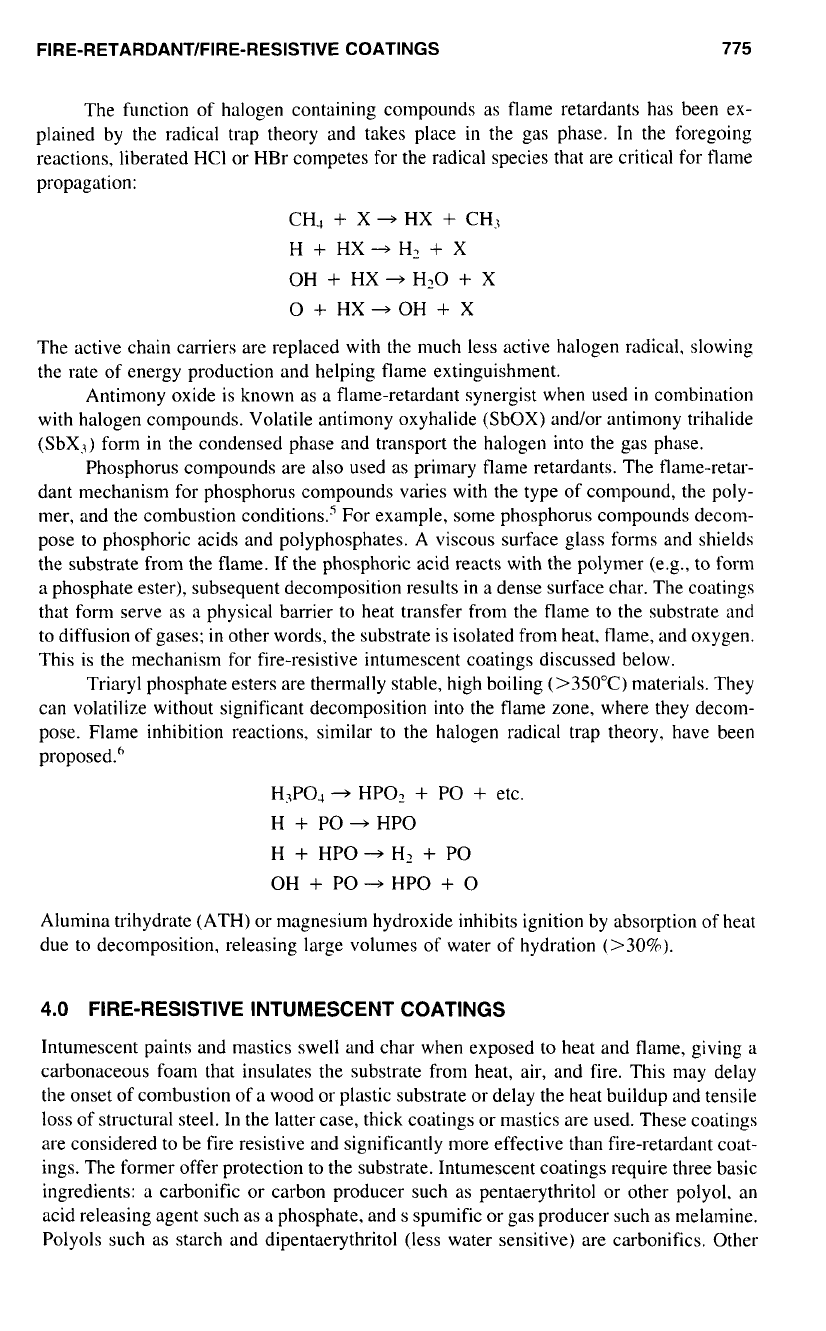
FIRE-RETARDANT/FIRE-RESISTIVE
COATINGS
775
The function of halogen containing compounds as flame retardants has been ex-
plained by the radical trap theory and takes place
in
the gas phase. In the foregoing
reactions, liberated HCI or HBr competes for the radical species that are critical for tlame
propagation:
CH4
+
X
+
HX
+
CH3
H
+
HX-H,
+
X
OH
+
HX
+
H20
+
X
0
+
HX-OH
+
X
The active chain carriers are replaced with the much less active halogen radical, slowing
the rate of energy production and helping flame extinguishment.
Antimony oxide is known as a flame-retardant synergist when used
in
combination
with halogen compounds. Volatile antimony oxyhalide (SbOX) and/or antimony trihalide
(SbX3) form in the condensed phase and transport the halogen into the gas phase.
Phosphorus compounds are also used as primary flame retardants. The tlame-retar-
dant mechanism for phosphorus compounds varies with the type of compound, the poly-
mer, and the combustion conditiomS For example, some phosphorus compounds decom-
pose to phosphoric acids and polyphosphates. A viscous surface glass forms and shields
the substrate from the flame. If the phosphoric acid reacts with the polymer (e.g., to form
a phosphate ester), subsequent decomposition results
in
a dense surface char. The coatings
that form serve as a physical barrier to heat transfer from the flame
to
the substrate and
to diffusion
of
gases;
in
other words, the substrate is isolated from heat, flame, and oxygen.
This is the mechanism for fire-resistive intumescent coatings discussed below.
Triaryl phosphate esters are thermally stable, high boiling
(>35OoC)
materials. They
can volatilize without significant decomposition
into
the flame zone, where they decom-
pose. Flame inhibition reactions, similar to the halogen radical trap theory, have been
proposed.'
H3P04
+=
HPO,
+
PO
+
etc.
H
+
PO
-
HP0
H
+
HP0
+
H2
+
PO
OH
+
PO
-+
HP0
+
0
Alumina trihydrate (ATH) or magnesium hydroxide inhibits ignition by absorption of heat
due to decomposition, releasing large volumes of water of hydration
(>30%).
4.0
FIRE-RESISTIVE INTUMESCENT COATINGS
Intumescent paints and mastics swell and char when exposed
to
heat and flame, giving a
carbonaceous foam that insulates the substrate from heat, air, and fire. This may delay
the onset of combustion of a wood or plastic substrate or delay the heat buildup and tensile
loss
of
structural steel. In the latter case, thick coatings or mastics are used. These coatings
are considered to be fire resistive and significantly more effective than fire-retardant coat-
ings. The former offer protection to the substrate. Intumescent coatings require three basic
ingredients: a carbonific or carbon producer such as pentaerythritol or other polyol. an
acid releasing agent such as a phosphate, and
S
spumific or gas producer such as melamine.
Polyols such as starch and dipentaerythritol (less water sensitive) are carbonifics. Other
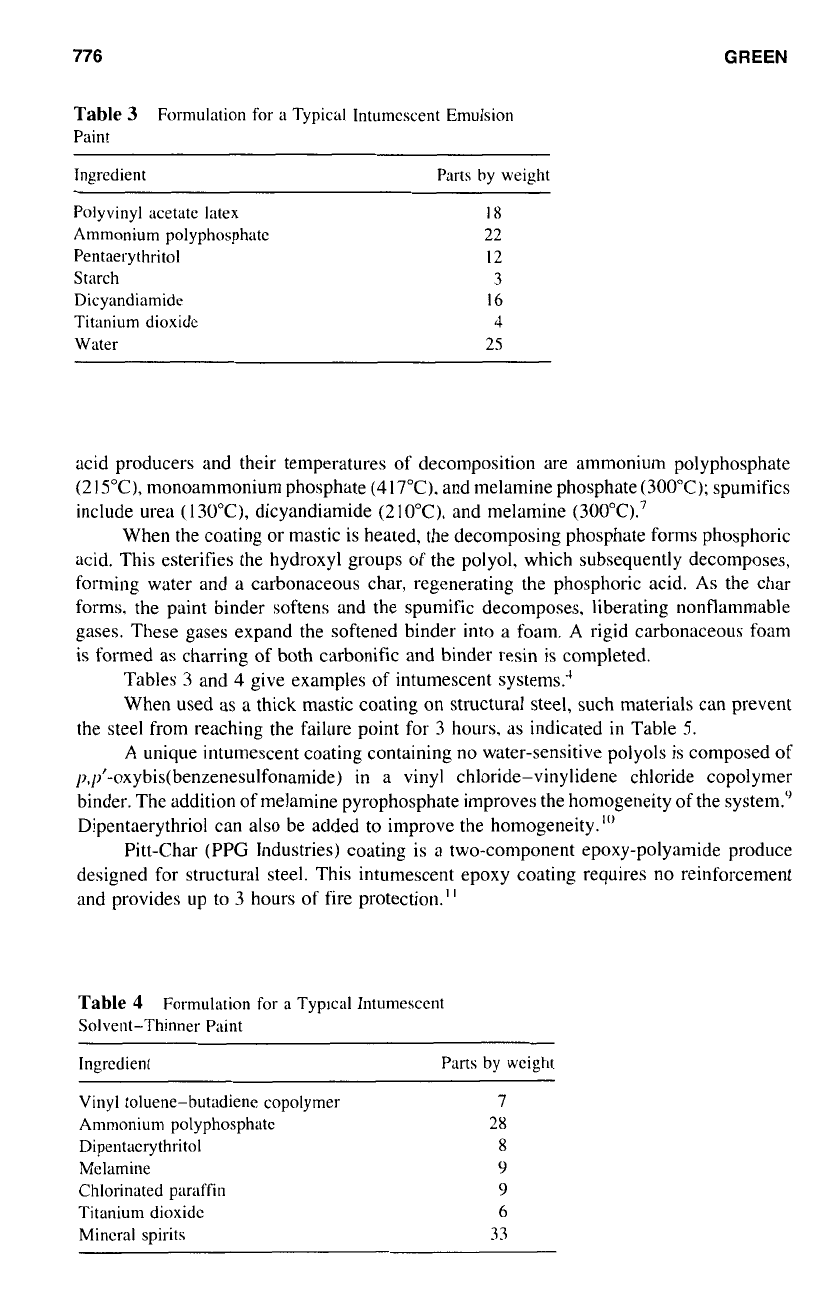
776
GREEN
Table
3
Formulation
for
a
Typical lntumcscent Emulsion
Paint
Ingrcdient Parts
by
weight
~~~~ ~
Polyvinyl acetate latex
Ammonium
polyphosphatc
Pentaerythritol
Starch
Dicyandiamide
Titanium dioxidc
Water
18
22
12
3
16
4
25
acid producers and their temperatures
of
decomposition are ammonium polyphosphate
(2
15"C),
monoammonium phosphate
(4
17°C).
and melamine phosphate
(300°C);
spumifics
include urea
(
13O"C),
dicyandiamide
(2
10°C).
and melamine
(300°C).7
When the coating or mastic is heated, the decomposing phosphate forms phosphoric
acid. This esterifies the hydroxyl groups of the polyol, which subsequently decomposes,
forming water and a carbonaceous char, regenerating the phosphoric acid.
As
the char
forms, the paint binder softens and the spumific decomposes. liberating nonflammable
gases. These gases expand the softened binder into a foam.
A
rigid carbonaceous foam
is formed as charring
of
both carbonific and binder resin is completed.
Tables
3
and
4
give examples
of
intumescent systems.'
When used as a thick mastic coating on structural steel, such materials can prevent
the steel from reaching the failure point for
3
hours, as indicated
in
Table
S.
A
unique intumescent coating containing
no
water-sensitive polyols is composed
of
/?,p'-oxybis(benzenesulfonamide)
in a vinyl chloride-vinylidene chloride copolymer
binder. The addition of melamine pyrophosphate improves the homogeneity of the system."
Dipentaerythriol can
also
be
added
to
improve the homogeneity."'
Pitt-Char (PPG Industries) coating is a two-component epoxy-polyamide produce
designed for structural steel. This intumescent epoxy coating requires no reinforcement
and provides up to
3
hours of fire protection."
Table
4
Formulation
for
a
Typical Intumescent
Solvent-Thinner Paint
Ingredient Parts
by
wcight
Vinyl
toluene-butadiene copolymer
Ammonium polyphosphatc
Dipentacrythritol
Mclamine
Chlorinated paraffin
Titanium dioxidc
Mincral spirits
7
28
8
9
9
6
33
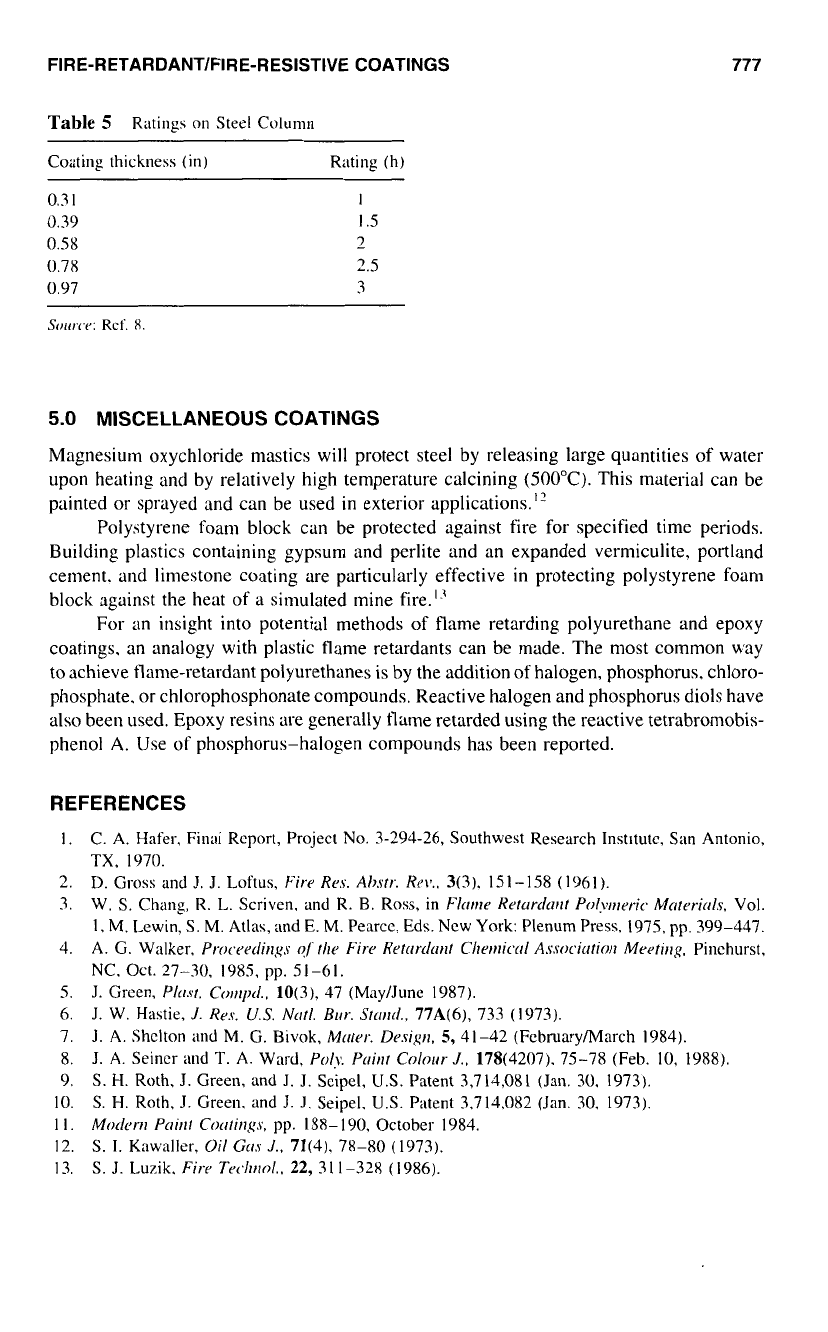
FIRE-RETARDANT/FIRE-RESISTIVE COATINGS
777
Table
5
Ratings
on
Steel Column
Coating thickness
(in)
Rating (h)
0.3
1
1
0.39
I
.5
0.58
2
0.78
2.5
0.97 3
Sorrrcr:
Ref.
X.
5.0
MISCELLANEOUS COATINGS
Magnesium oxychloride mastics will protect steel by releasing large quantities of water
upon heating and by relatively high temperature calcining
(500°C).
This material can be
painted or sprayed and can be used in exterior applications."
Polystyrene foam block can be protected against fire for specified time periods.
Building plastics containing gypsum and perlite and an expanded vermiculite, portland
cement, and limestone coating are particularly effective
in
protecting polystyrene foam
block
against the heat of a simulated mine fire.'>
For an insight into potential methods
of
flame retarding polyurethane and epoxy
coatings. an analogy with plastic flame retardants can be made. The most common way
to achieve tlame-retardant polyurethanes is by the addition
of
halogen, phosphorus, chloro-
phosphate. or chlorophosphonate compounds. Reactive halogen and phosphorus diols have
also been used. Epoxy resins are generally flame retarded using the reactive tetrabromobis-
phenol
A.
Use of phosphorus-halogen compounds has been reported.
REFERENCES
1.
C.
A.
Hafer, Final Rcport, Project No. 3-294-26, Southwest Research Instltutc, San Antonio,
2.
D.
Gross
and
J.
J.
Loftus,
Fire
Res.
Ahstr.
Re\:.
3(3).
151-158
(1961).
3.
W.
S.
Chang, R. L. Scriven. and R.
B.
Ross, in
Fltrrr~e
Rettrrtkrr~t
Polwwric
Motrrirrls.
Vol.
1.
M.
Lewin,
S.
M.
Atlas,
and E.
M.
Pearcc.
Eds.
New York: Plenum Press, 1975,
pp.
399-447.
4.
A.
G.
Walker.
Procwdirlty.s
of
the
Fire
Rettrr~ht Cherrlicrtl
Associtrtiou
Meetir~~.
Pinchurst,
5.
J. Green,
Pltrst.
Corriptl..
lO(3).
47
(Mny/June 1987).
6.
J. W. Hastie,
J.
Res.
U.S.
Ntrtl.
Birr.
Strrrrd.,
77A(6),
733 (1073).
7.
J.
A.
Shclton and
M.
G. Bivok,
Mttrer.
Drsip~,
S,
41-42
(FcbruaryNarch 1984).
8.
J.
A.
Seiner and
T.
A.
Ward,
Poly.
Prrirlt
Coloirr.
J.,
178(4207). 75-78
(Feb.
10,
1988).
9.
S.
H.
Roth, J. Green, and J. J. Scipel,
US.
Patent
3,714,081
(Jan.
30.
1973).
10.
S.
H. Roth, J. Green. and
J.
J.
Seipel.
U.S.
Patent
3,714.082
(Jan.
30. 1973).
1
1.
Motkcw~
Ptrirrt
Cotrting.~,
pp.
188-
190,
October 1984.
13.
S.
J. Luzik.
Fire
Techr~ol..
22,
31
1-328
(1986).
TX,
1970.
NC. Oct.
27-30.
1985, pp.
51-61.
12.
S.
1.
K~~wall~,
Oil
G/.s
J..
71(4).
78-80 (1973).
This Page Intentionally Left Blank
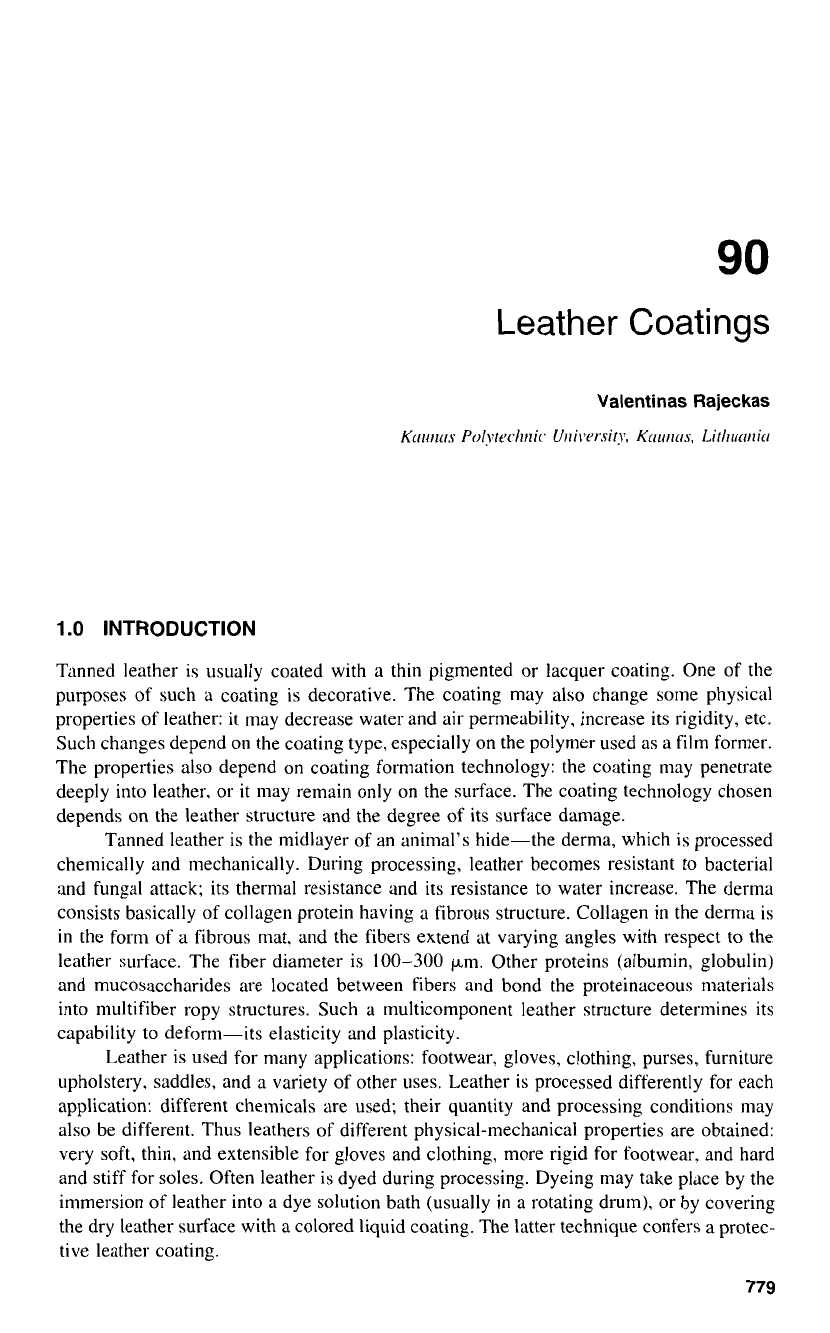
90
Leather Coatings
1
.O
INTRODUCTION
Tanned leather is usually coated with a thin pigmented or lacquer coating. One of the
purposes of such a coating is decorative. The coating may also change some physical
properties
of
leather:
it
may decrease water and air permeability, increase its rigidity, etc.
Such changes depend
on
the coating type, especially
on
the polymer used as a film former.
The properties also depend
on
coating formation technology: the coating may penetrate
deeply into leather. or
it
may remain only on the surface. The coating technology chosen
depends on the leather structure and the degree of its surface damage.
Tanned leather is the midlayer of an animal’s hide-the derma, which is processed
chemically and mechanically. During processing, leather becomes resistant
to
bacterial
and fungal attack; its thermal resistance and its resistance to water increase. The derma
consists basically of collagen protein having a fibrous structure. Collagen in the derma is
in
the form of a fibrous mat. and the fibers extend at varying angles with respect
to
the
leather surface. The fiber diameter is
100-300
pm. Other proteins (albumin, globulin)
and mucosaccharides are located between fibers and bond the proteinaceous materials
into multifiber ropy structures. Such a multicomponent leather structure determines its
capability to deform-its elasticity and plasticity.
Leather is used for many applications: footwear, gloves, clothing, purses, furniture
upholstery, saddles, and a variety of other uses. Leather
is
processed differently for each
application: different chemicals are used; their quantity and processing conditions may
also be different. Thus leathers of different physical-mechanical properties are obtained:
very soft, thin, and extensible for gloves and clothing, more rigid for footwear. and hard
and stiff for soles. Often leather is dyed during processing. Dyeing may take place by the
immersion of leather into a dye solution bath (usually in a rotating drum), or by covering
the dry leather surface with a colored liquid coating. The latter technique confers a protec-
tive leather coating.
779
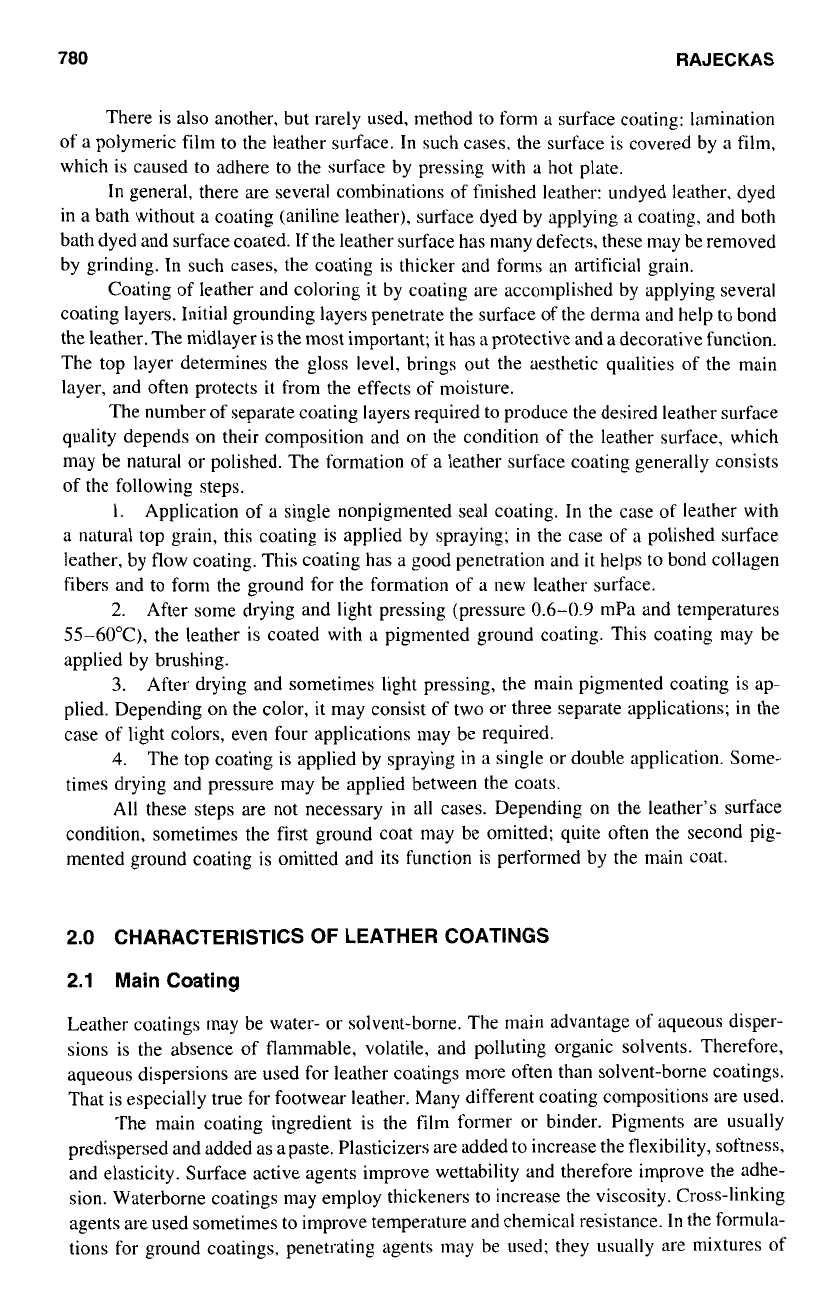
780
RAJECKAS
There is also another, but rarely used, method to form a surface coating: lamination
of a polymeric film to the leather surface.
In
such cases. the surface is covered by a film,
which is caused to adhere to the surface by pressing with a hot plate.
In
general, there are several combinations
of
finished leather: undyed leather, dyed
in a bath without a coating (aniline leather), surface dyed by applying a coating, and both
bath dyed and surface coated. If the leather surface has many defects, these may be removed
by grinding. In such cases, the coating is thicker and forms an artificial grain.
Coating of leather and coloring
it
by coating are accomplished by applying several
coating layers. Initial grounding layers penetrate the surface of the derma and help to bond
the leather. The midlayer is the most important; it has
a
protective and a decorative function.
The top layer determines the gloss level, brings out the aesthetic qualities of the main
layer, and often protects it from the effects of moisture.
The number of separate coating layers required to produce the desired leather surface
quality depends on their composition and on the condition
of
the leather surface, which
may be natural or polished. The formation of a leather surface coating generally consists
of
the following steps.
1.
Application
of
a single nonpigmented seal coating.
In
the case of leather with
a
natural top grain, this coating is applied by spraying;
in
the case of a polished surface
leather, by flow coating. This coating has a good penetration and it helps
to
bond collagen
fibers and to form the ground for the formation of a new leather surface.
2.
After some drying and light pressing (pressure
0.6-0.9
mPa and temperatures
55-60°C),
the leather is coated with a pigmented ground coating. This coating may be
applied by brushing.
3.
After drying and sometimes light pressing, the main pigmented coating is ap-
plied. Depending on the color,
it
may consist of two or three separate applications; in the
case of light colors, even four applications may be required.
4.
The top coating is applied by spraying
in
a single or double application. Some-
times drying and pressure may be applied between the coats.
All these steps are not necessary
in
all
cases. Depending on the leather's surface
condition, sometimes the first ground coat may be omitted; quite often the second pig-
mented ground coating is omitted and its function is performed by the main coat.
2.0
CHARACTERISTICS
OF
LEATHER COATINGS
2.1
Main Coating
Leather coatings may be water- or solvent-borne. The main advantage
of
aqueous disper-
sions is the absence of flammable, volatile, and polluting organic solvents. Therefore,
aqueous dispersions are used for leather coatings more often than solvent-borne coatings.
That is especially true for footwear leather. Many different coating compositions are used.
The main coating ingredient is the film former or binder. Pigments are usually
predispersed and added
as
a paste. Plasticizers are added to increase the flexibility, softness,
and elasticity. Surface active agents improve wettability and therefore improve the adhe-
sion. Waterborne coatings may employ thickeners to increase the viscosity. Cross-linking
agents are used sometimes
to
improve temperature and chemical resistance. In the formula-
tions for ground coatings, penetrating agents may be used; they usually are mixtures of
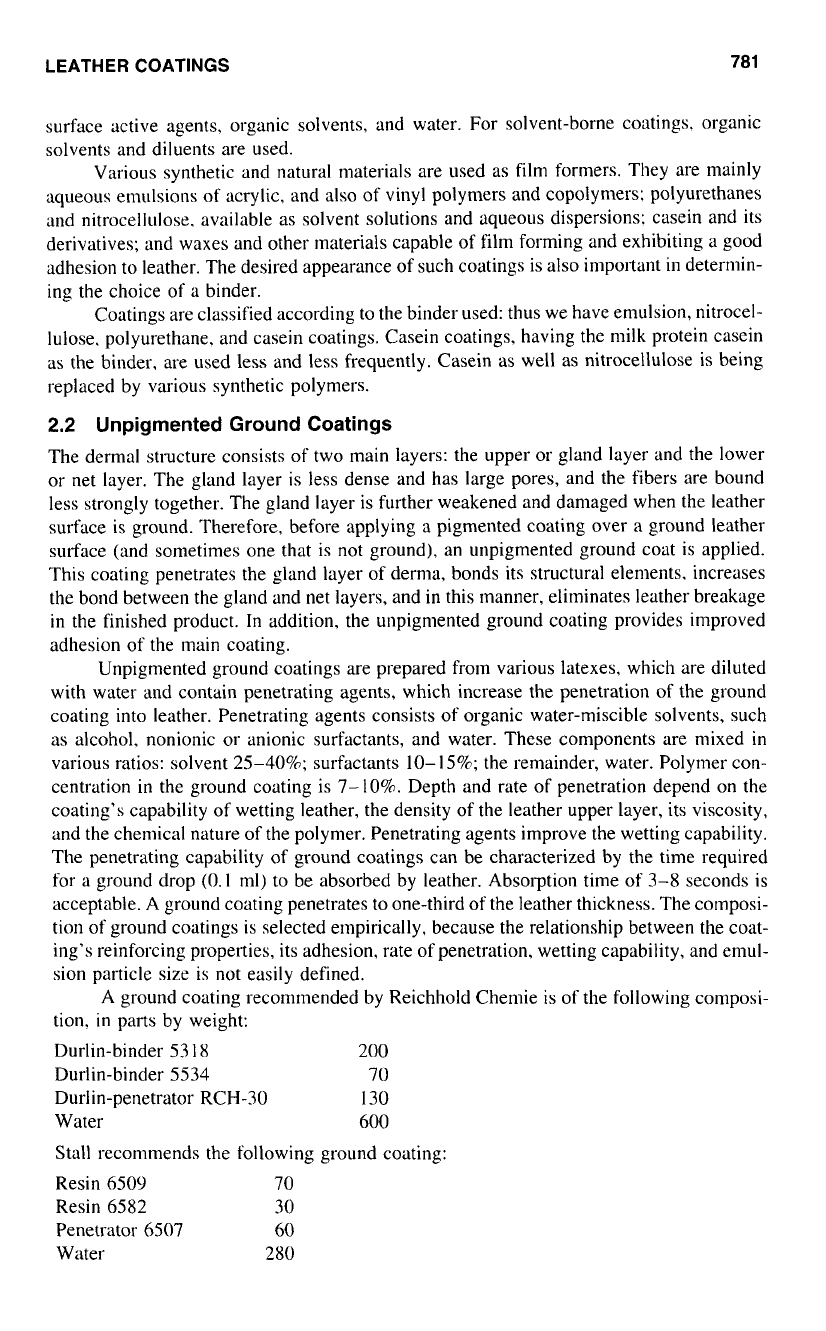
LEATHER
COATINGS
781
surface active agents, organic solvents, and water. For solvent-borne coatings, organic
solvents and diluents are used.
Various synthetic and natural materials are used as film formers. They are mainly
aqueous emulsions
of
acrylic, and also
of
vinyl polymers and copolymers: polyurethanes
and nitrocellulose. available
as
solvent solutions and aqueous dispersions: casein and its
derivatives; and waxes and other materials capable
of
film forming and exhibiting
a
good
adhesion to leather. The desired appearance of such coatings is also important in determin-
ing the choice of a binder.
Coatings are classified according to the binder used: thus we have emulsion, nitrocel-
lulose. polyurethane. and casein coatings. Casein coatings, having the milk protein casein
as the binder. are used less and less frequently. Casein as well
as
nitrocellulose is being
replaced by various synthetic polymers.
2.2
Unpigmented Ground Coatings
The dermal structure consists
of
two main layers: the upper or gland layer and the lower
or net layer. The gland layer is less dense and has large pores, and the fibers are bound
less strongly together. The gland layer is further weakened and damaged when the leather
surface is ground. Therefore, before applying a pigmented coating over
a
ground leather
surface (and sometimes one that is not ground), an unpigmented ground coat is applied.
This coating penetrates the gland layer of derma, bonds its structural elements. increases
the bond between the gland and net layers, and in this manner, eliminates leather breakage
in the finished product.
In
addition, the unpigmented ground coating provides improved
adhesion of the main coating.
Unpigmented ground coatings are prepared from various latexes, which are diluted
with water and contain penetrating agents, which increase the penetration
of
the ground
coating into leather. Penetrating agents consists of organic water-miscible solvents, such
as
alcohol, nonionic or anionic surfactants, and water. These components are mixed
in
various ratios: solvent
25-40%;
surfactants
10-15%;
the remainder, water. Polymer con-
centration
in
the ground coating is 7-10%. Depth and rate of penetration depend on the
coating's capability of wetting leather, the density of the leather upper layer, its viscosity,
and the chemical nature of the polymer. Penetrating agents improve the wetting capability.
The penetrating capability
of
ground coatings can be characterized by the time required
for a ground drop
(0.
I
ml) to be absorbed by leather. Absorption time
of
3-8 seconds is
acceptable.
A
ground coating penetrates to one-third
of
the leather thickness. The composi-
tion
of
ground coatings is selected empirically, because the relationship between the coat-
ing's reinforcing properties, its adhesion, rate of penetration, wetting capability, and emul-
sion particle size is not easily defined.
A ground coating recommended by Reichhold Chemie is of the following composi-
tion.
in
parts by weight:
Durlin-binder 53 18 200
Durlin-binder 5534 70
Durlin-penetrator RCH-30 130
Water
600
Stall recommends the following ground coating:
Resin 6509 70
Resin 6582 30
Penetrator 6507
60
Water 280
